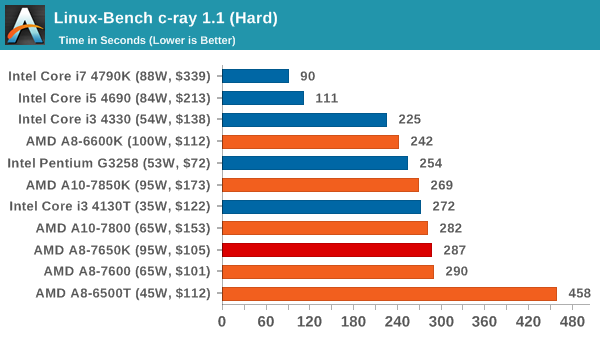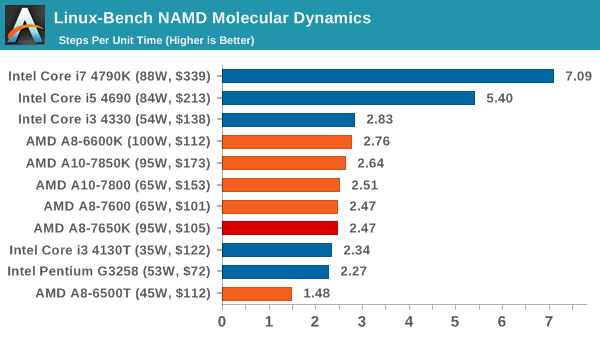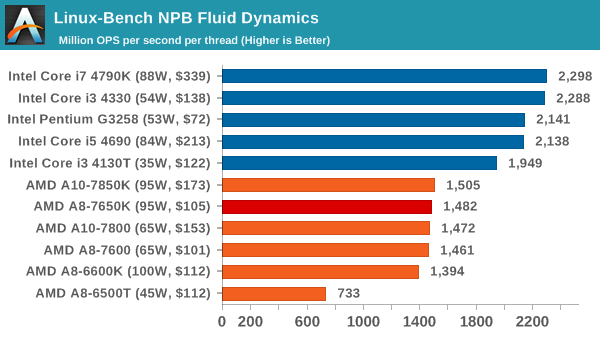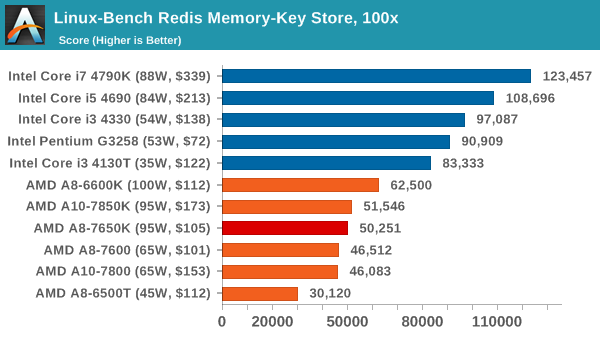The AMD A8-7650K APU Review, Also New Testing Methodology
by Ian Cutress on May 12, 2015 10:00 AM ESTProfessional Performance: Linux
Built around several freely available benchmarks for Linux, Linux-Bench is a project spearheaded by Patrick at ServeTheHome to streamline about a dozen of these tests in a single neat package run via a set of three commands using an Ubuntu 11.04 LiveCD. These tests include fluid dynamics used by NASA, ray-tracing, OpenSSL, molecular modeling, and a scalable data structure server for web deployments. We run Linux-Bench and have chosen to report a select few of the tests that rely on CPU and DRAM speed.
C-Ray: link
C-Ray is a simple ray-tracing program that focuses almost exclusively on processor performance rather than DRAM access. The test in Linux-Bench renders a heavy complex scene offering a large scalable scenario.

Being a scaling benchmark, C-Ray prefers threads and seems more designed for Intel.
NAMD, Scalable Molecular Dynamics: link
Developed by the Theoretical and Computational Biophysics Group at the University of Illinois at Urbana-Champaign, NAMD is a set of parallel molecular dynamics codes for extreme parallelization up to and beyond 200,000 cores. The reference paper detailing NAMD has over 4000 citations, and our testing runs a small simulation where the calculation steps per unit time is the output vector.

NAMD is similar to our office benchmarks, puttin the bulk of the APUs between the i3-4130T and the i3-4330.
NPB, Fluid Dynamics: link
Aside from LINPACK, there are many other ways to benchmark supercomputers in terms of how effective they are for various types of mathematical processes. The NAS Parallel Benchmarks (NPB) are a set of small programs originally designed for NASA to test their supercomputers in terms of fluid dynamics simulations, useful for airflow reactions and design.

Despite the rated memory on the APUs being faster, NPB seems to require more IPC than DRAM speed.
Redis: link
Many of the online applications rely on key-value caches and data structure servers to operate. Redis is an open-source, scalable web technology with a b developer base, but also relies heavily on memory bandwidth as well as CPU performance.











177 Comments
View All Comments
silverblue - Thursday, May 14, 2015 - link
I've often wondered if the G3258 is really the better choice in this price range. Sure, there are titles it cannot play, but workarounds exist in one or two titles to allow it to work. Newer titles may indeed render it obselete, but there's always the argument about buying a better CPU for the platform later on. Additionally, it overclocks like buggery if you feel that way inclined; how long has it been since we had a CPU that could be overclocked by 50% without costing the earth in power?The concern I have with upgrading just the CPU is that Intel doesn't stick with its sockets for a long time, and if you're buying a CPU that will eventually become as useful as a chocolate fireguard when playing modern titles, it'd make more sense to buy its i3 cousins in the first place. AMD is banking on you considering its quad core APUs for this, however they have their flaws too - FM2+ has a year left (Carrizo is destined for FM3 along with Zen), they don't overclock as well, power usage is higher even during idle, and the GPU-less derivatives don't appear to be any faster. H81 boards aren't expensive, either, for overclocking that Pentium. Still, you really do need a discrete card with the G3258/Athlons, whereas the APUs and i3 have enough iGPU grunt to go into an HTPC if you're not gaming heavily.
Decisions, decisions... and right now, I'm wondering how I could even consider AMD. Has anybody made systems for both Pentium and Athlon/APU systems and can share their thoughts?
Tunnah - Tuesday, May 12, 2015 - link
Nice review, covers pretty much everything, and says what I guess everyone was expecting.One thing I wondered though, why choose the 770 for mid-range when the 960 is a much more logical choice ? Price wise it's £140 here in UK so I guess about $200 over the pond, and is a much more competent card than the 770
Ian Cutress - Wednesday, May 13, 2015 - link
Because I've had 770s in as part of my test bed for 18 months. The rest of the cards (290X, 980, 285) I've sourced for my 2015 testing, and it's really hard to source GPUs for testing these days - I had to personally purchase the 285 for example, because I felt it was extremely relevant. Unfortunately we don't all work in a big office to pass around hardware!meacupla - Wednesday, May 13, 2015 - link
If you do ever get a GTX 960 or 750Ti, it would be nice to see some total system power consumption numbers between overclocked A8-7650K+R7 240 vs. i3-4xxx+750Ti vs. overclocked G3258+750TiDrazick - Wednesday, May 13, 2015 - link
Hello,Could you please add MATLAB to your performance benchmark?
Or at least Python / Julia.
We need data about scientific computation.
Thank You.
UtilityMax - Wednesday, May 13, 2015 - link
"Scientific computation" is a somewhat amorphous term. Moreover, I don't know if there exists a benchmark suite for either Matlab or Python. In any case, Matlab and Python or both used in numerics as fast prototyping tools or for computations where the compute time is inconsequential. If you're running in speed issues with Matlab it's time to start coding in something else, although in from my observations, most people who run into performance issues with Matlab don't know how to optimize Matlab code for speed. Most don't know how to code at all.freekier93 - Wednesday, May 13, 2015 - link
Your really don't know what you're talking about... Matlab is SO much more than fast prototyping software. I have quite a few programs what would be good speed tests, one of which being a full non-linear aircraft dynamics Simulink simulation. A 5 minute simulation could easily take 2 minutes of compute time. Anything that starts getting into serious differential equations takes compute time.Ian Cutress - Wednesday, May 13, 2015 - link
3DPM is a Brownian Motion based benchmark, and Photoscan does interesting 2D to 3D correlation projections. The Linux benchmarks also include NAMD/NPB, both of which are hardcore scientific calculations.Smile286 - Wednesday, May 13, 2015 - link
Author, do you know about existence of 'Haswell Refresh' CPU models? It's basically the same 'Haswell' with +100/+200/+300 MHz to their x86-core's speed. Why not use them in tests? It's not like it's 2013 right now, when i3-4330 was released. FYI, i3-4370 have the same $138 MSRP (tray) as i3-4330, but it +300 MHz faster.Same story about i3-4130 and i3-4170: +300 MHz for i3-4170 basically for free.
You should put them in test rather an old 'Haswell' core i3 models. Thanks.
zodiacfml - Wednesday, May 13, 2015 - link
How could a next generation API improve AMD's APU performance if it already has decent if not very good performance in integrated 3D graphics (beating the lowest end discrete)?AMD still needs better CPU performance as it shows poorer value compared to an Intel of near or similar price (without considering the GPU).
The occasional gaming niche is pretty nil too as that kind can be accomplished in a notebook, tablet, or smartphone.
This remains valuable for people with regular gaming in mind but with absolutely limited budget. I see myself getting this for getting back into Diablo 3 after a day from work but saving a bit more, I might as well get a decent laptop.